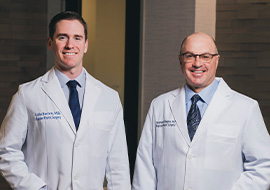Chalazion and Stye
Incision and Curettage of Chalazia and Hordeola
Surgical Treatment
Chronic, cyst-like lesions that have not resolved with several weeks of lid margin scrubs and warm compresses may require surgical management. Topical eye drops and a local injection provide anesthesia to the eyelid area. A chalazion clamp is applied to the affected area and helps evert and stabilize the eyelid during the procedure. A posterior incision (on the inside of the eyelid), excision of the posterior cyst-like wall, and curettage of the involved area is performed as an office procedure with local anesthetic. Less frequently, an anterior incision is made through the skin if the lesion is “pointing” through the skin. If the skin overlying a chalazion/hordeolum has become thin and damaged due to chronic inflammation, then suture wound repair is occasionally indicated. Eye patches are not typically needed. A combined antibiotic-steroid eye drop (daily use) and/or ointment (evening use) may be prescribed for one week. Ice packs should be applied the first few days following the procedure and then warm compresses may be resumed.
What to Expect Following Chalazion or Stye Removal
Recovery from chalazion and stye surgery varies from patient to patient and will also depend on the size, number, and location of the chalazia requiring removal. Swelling and redness of the area will be greatest during the first 3-4 days and slowly resolve over a few weeks. Some drainage may be experienced for up to 2-3 weeks as most of the wound healing occurs on the inside of the eyelid. During this time the eyelids may occasionally stick together, particularly upon awakening. The recovery from chalazion and stye surgery tends to be longer than other limited eyelid procedures (biopsies, mole or skin tag removal, etc.)
Eyelid Margin Lesions
Small lesions involving the eyelid margin (near the base of the eyelashes) are frequently the most difficult to manage. Aggressive surgical management may result in lid margin deformities necessitating further eyelid reconstructive procedures. Local injections of corticosteroids may rarely be helpful with difficult marginal lesions.
Recurrent Chalazia
Chalazia that recur despite appropriate surgical management should be biopsied to determine if an occult malignant lesion, such as sebaceous cell carcinoma exists.
Klapper Eyelid & Facial Plastic Surgery treats disorders, injuries, and other abnormalities of the eyelids, eyebrow, tear duct system, eye socket, and adjacent areas of the mid and upper face.

